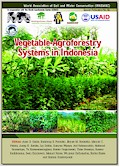| Book Chapter |
 |
|
| Title | Socioeconomic baseline studies: agroforestry and sustainable vegetables production in Southeast Asian watershed case study, Nanggung subdistrict, Bogor, Indonesia | | Author | Kusuma Wijaya, Suseno Budidarsono and James M Roshetko | | Editors | Anas D Susila, Bambang S. Purwoko, James M Roshetko, Manuel C. Palada, Juang G. Kartika, Lia Dahlia, Kusuma Wijaya, Arif Rahmanulloh, Mahmud Raimadoya, Tri Koesoemaningtyas, Herien Puspitawati, Tisna Prasetyo, Suseno Budidarsono, Iwan Kurniawan, Manuel Reyes, Wanraya Suthumchai, Karika Kunta and Samran Sombatpanit | | Year | 2012 | | Book Title | Vegetable-agroforestry sistems in Indonesia | | Publisher | World Association of Soil and Water Conservation (WASWAC), Bangkok, Thailand and the World Agroforestry Center (ICRAF), Nairobi, Kenya | | City of Publication | Bangkok, Thailand | | Number of Pages of the book | 48 | | Pages | 249-296 | | Call Number | BC0334-12 | | Keywords | Baseline, vegetable, agroforestry, socioeconomics, Nanggung |
|
| Abstract: |
| This report provides basic socioeconomic data on the study site,
namely Kecamatan Nanggung, a subdistrict located in the western part of
West Java Province. The study employed a combination of Rapid Rural Ap-
praisal (RRA) technique (to gather data/information at the village level within
the subdistrict) and a household survey (to gather data/information at the
household level, emphasizing the livelihood and agricultural practices of the
respondents). The study site is accessible to two progressive urban centers
(Bogor and Jakarta), rich in natural resources (forest and minerals) and has an
ideal climate for agriculture. However, most farmers had limited access to
professional technical assistance and poor market linkage, particularly with
the more progressive urban and regional markets nearby. At the household
level, the study reveals that the problems were not merely access to land or
landholding size, but also the low level education of most farmers (87.6%
never went beyond the elementary level). Based on the average per capita in-
come of the surveyed households in three sample villages, about half (52%)
of the surveyed households were living below the poverty line and thus are
categorized as poor. Among the sample villages, Hambaro was the poorest,
with about 67.7% of its population living below the poverty line. |
|